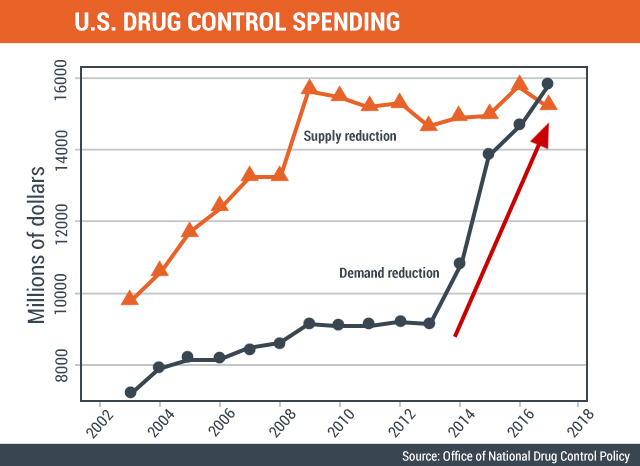 For the next couple of years, drug and crime reduction will likely remain at the forefront of the national development agenda.
For the next couple of years, drug and crime reduction will likely remain at the forefront of the national development agenda.
So for many people, rather than ask why this drug war should be waged, perhaps the more important question to ask is how.
There are two main strategies. On the one hand, President Rodrigo Duterte is pursuing an aggressive drug war that aims to reduce the supply of illegal drugs entering and circulating in the country.
On the other hand, some – like Vice President Leni Robredo – advocate alternative measures such as rehabilitation and education among the youth to curb the demand for drugs.
Indeed, just like any market, the market for illegal drugs follows the laws of supply and demand. But which will work better to reduce drug use and its ill effects on society?
Does supply reduction work?
Let’s start with the traditional way of tackling illegal drugs: by limiting its supply through prohibition. This immediately creates a shortage that raises its price in the black market.
Indeed, reports show that the Duterte drug war has already raised drug prices in certain areas. In Manila, one report said that the price of shabu has “doubled because of the drug war”. In Central Visayas, the PDEA reported that as of September 1 the price of shabu has risen from P1,500/gram to P6,500/gram because of the intensified crackdowns.
However, drugs are addicting. So even if they become much more expensive, this will not make a proportional dent on the quantity of drugs demanded by users. In other words, the demand for drugs is not very responsive to changes in drug prices.
Several empirical studies have shown this to be true. Estimates vary, but a 2006 study cowritten by Nobel Prize winner Gary Becker found that, on average, for every increase in the price of drugs (say, 10%), drug purchases tend to decrease only by half that magnitude (in this case, 5%).
So when a government imposes a prohibition that reduces supply, drug suppliers sell more or less the same quantity as before, but at higher prices. This often leads to even larger drug sales and revenues than before.
This combo of higher prices and revenues allows drug suppliers access to larger stashes of cash which they can spend on more manpower, weapons, bribes, etc – all of which only serve to expand their operations and escalate overall violence.

Furthermore, by making drug production and importation more difficult, only the biggest and most efficient drug syndicates can survive in the market. This drives away their competition and grants them monopoly power in the black market, making them thrive.
Nowhere is this more apparent than in the US, which has waged an intensive drug war since the 1970s. More than 40 years have elapsed and a trillion dollars have been spent since the war started. Yet drug cartels are larger than ever and continue to earn billions of dollars that they invest in R&D and expensive equipment like giant catapults and “narco-submarines”.
Therefore, a drug war that focuses disproportionately on supply reduction tends to strengthen and enrich – rather than weaken and impoverish – the operations of drug suppliers.
Does demand reduction work?
The country’s drug war can be fought not only on the supply front, but also on the demand front.
Education and prevention campaigns among the youth, or rehabilitation among drug users, eventually lead to a surplus of illegal drugs in the market. For drug suppliers, the only way they can eliminate their stocks is by charging lower prices.
As a result, demand reduction not only reduces drug use (like supply reduction does), but more importantly, drug prices and revenues as well. The amount that drug users need to pay their suppliers necessarily decrease, and this obviates the need for drug users to commit more crime, leading to fewer drug-related crimes.
Demand interventions also tend to be cheaper: one report says that, “A dollar spent on drug education in US schools cuts cocaine consumption by twice as much as spending that dollar on reducing supply in South America; spending it on treatment for addicts reduces it by 10 times as much.”
As a testament to the relative effectiveness of demand reduction over supply reduction, more and more countries are rethinking their drug policies in recent years.
In 2017, for example, the US is proposing to spend more on demand reduction than supply reduction for the very first time since their drug war started (see the graph below). Similarly, a number of governments in historically drug-ridden countries in Latin America – including Colombia, Ecuador, Guatemala, and Uruguay – are also rethinking their approach to drugs.

Conclusion: Drug addiction as a public health problem
The two arms of drug policy – supply reduction and demand reduction – are not incompatible. But supply reduction tends to increase drug sales (and strengthen suppliers), while demand reduction tends to decrease sales (and weaken suppliers).
Hence, rather than pursue tougher raids, arrests, and crackdowns, perhaps a more fruitful, lasting strategy in this drug war would be to strengthen prevention, education, and rehabilitation.
President Duterte already made promising statements in this direction. In his first SONA, he said that the government is “planning to increase spending on basic education and incorporate mandatory education about the evils of drugs”.
More and more countries are treating drug addiction as a public health problem, rather than a law enforcement problem. Let’s hope that our own policymakers take heed of this global rethink, and realize that the war on drugs can be fought not just on the supply side, but also – perhaps even more effectively – on the demand side. – Rappler.com
The author is a PhD student at the UP School of Economics. His views are independent of the views of his affiliations.